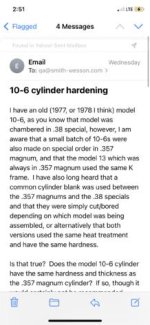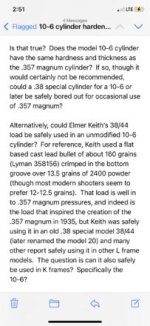I posted this in my other thread but I felt it deserved it's own because I have heard differing opinions on it. The question was whether the .38 special cylinders in the K frame (and the Model 10 specifically) had a different heat treat or wall thickness than the .357 magnum versions, well now we know, per Smith and Wesson themselves via email, so now the question should be settled, here is their response:
The heat treat specs are the same on the model 10. The wall thickness between the 38 and 357 is the same, what is different is the depth of the bullet seat. We do not support changing the caliber from the caliber that it originally left the factory as.
Thank you for choosing Smith & Wesson.
Have a great day!
Regards,
Carolyn
So it seems that there was indeed no difference in either the heat treating or wall thickness, however (predictably) Smith and Wesson still does not recommend converting .38 caliber cylinders to .357 magnum, likely for legal CYA reasons as there is apparently no mechanical reason not to.
The heat treat specs are the same on the model 10. The wall thickness between the 38 and 357 is the same, what is different is the depth of the bullet seat. We do not support changing the caliber from the caliber that it originally left the factory as.
Thank you for choosing Smith & Wesson.
Have a great day!
Regards,
Carolyn
So it seems that there was indeed no difference in either the heat treating or wall thickness, however (predictably) Smith and Wesson still does not recommend converting .38 caliber cylinders to .357 magnum, likely for legal CYA reasons as there is apparently no mechanical reason not to.



